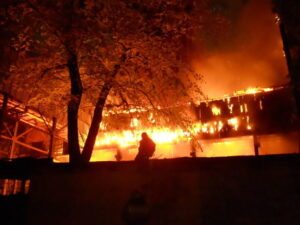
Drones are widely recognized as an indispensible tool in firefighting. Now, researchers from George Mason University are working on a drone and wearable sensor solution that can locate each firefighter working in a burning building – and notify their team if they’re in trouble.
Drones equipped with thermal and RTK imaging solutions are used heavily in firefighting, providing scene commanders with situational awareness and important thermal data that can help identify hotspots or areas likely to reignite. Aerial data can help with aspects of fire management like managing evacuations by understanding which roads are still accessible, distributing resources efficiently, and documenting the fire’s progress.
Now,Vijay Shah, an assistant professor in the Cyber Security Engineering Department in the College of Engineering and Computing at George Mason University is working to develop a tool that will locate and protect firefighters while they are working. Drones surrounding a fire will receive signals from wearable sensors on the firefighters: locating each individual for the commander to improve utilization of resources and direct firefighters to safer positions if required. If a firefighter has not moved in a certain amount of time, the system alerts the commander that a team member may need rescue.
The project, “5G Indoor Positioning System” is funded by the National Institute of Standards and Technology, and is part of a collaboration with Virginia Tech and the Arlington Virginia County Fire Department. Arlington firefighters will begin testing the technology starting in 2025.
From the George Mason article:
Advances in 5G network technology allow for this research because compared to other legacy wireless communications, 5G provides much greater accuracy and does not rely on equipment within the building, which may be damaged during a fire. A key development Shah and colleagues are exploiting is called “network slicing,” sending certain pieces of information over portions of the 5G network.
Shah says, “The critical information, such as location of the firefighter, is sent in one ‘slice’ and in a much smaller packet, allowing for virtually no delay in information relay. Transmitting audio/video information requires more data, but any information lost there simply reduces the quality of the audio/video, which is not as important as losing someone’s location. That information would be put in another slice.”
Researchers expect that the technology may be widely available to firefighters in a few years.
Read more about drones in firefighting:
- Fighting Wildfires with Advanced Technology Aerial Firefighting
- Advanced Technology Aerial Firefighting: the Dawn of Drones Podcast
- Drone Swarms for Firefighting: the Future of Fire Supression?
- FAA Wont Charge Rogue Drone Pilot Who Stopped Firefighting
Miriam McNabb is the Editor-in-Chief of DRONELIFE and CEO of JobForDrones, a professional drone services marketplace, and a fascinated observer of the emerging drone industry and the regulatory environment for drones. Miriam has penned over 3,000 articles focused on the commercial drone space and is an international speaker and recognized figure in the industry. Miriam has a degree from the University of Chicago and over 20 years of experience in high tech sales and marketing for new technologies.
For drone industry consulting or writing, Email Miriam.
TWITTER:@spaldingbarker
Subscribe to DroneLife here.
